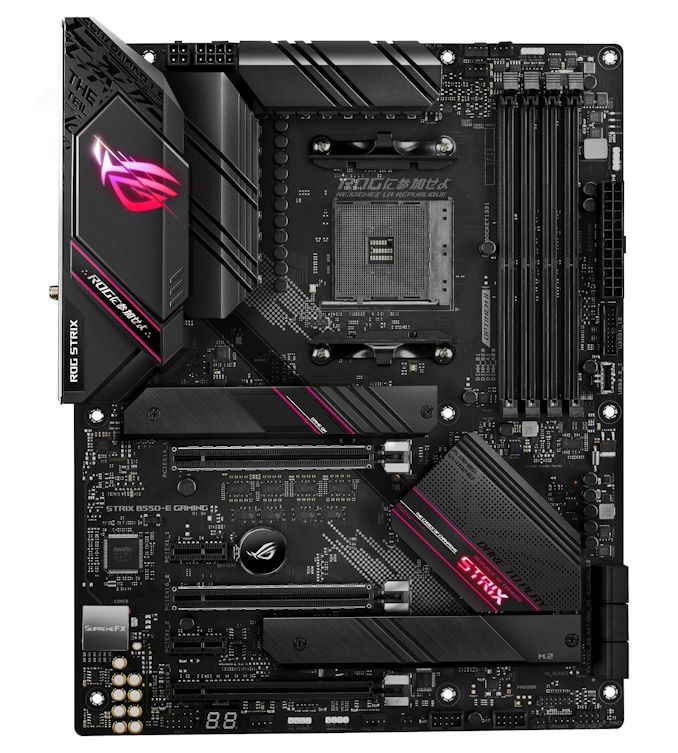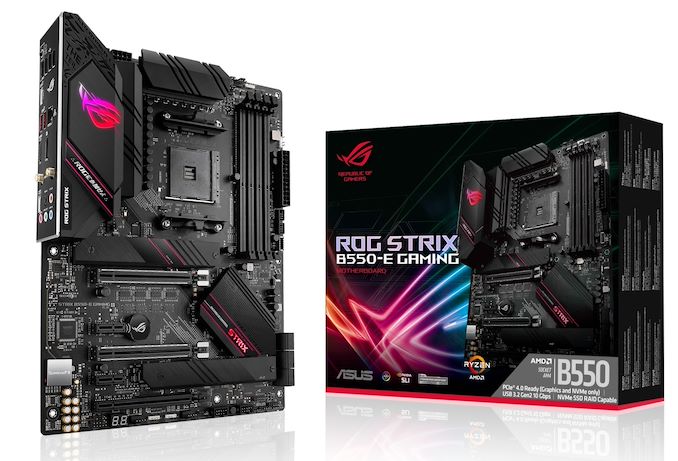The AMD B550 Motherboard Overview: ASUS, GIGABYTE, MSI, ASRock, and Others
by Dr. Ian Cutress & Gavin Bonshor on June 16, 2020 11:00 AM ESTASUS ROG Strix B550-E Gaming
Out of ASUS’ three main sub-brands for B550, the Strix is aimed at the higher end, and we get a range of options to play with. The B550-E Gaming is the more expensive of the bunch, at $280, although it is one of the few boards to offer x8/x8 functionality with its PCIe slots. The use of this configuration isn’t so much for gaming (despite the name), due to lack of SLI support, but it does enable a good setup for a machine based around GPU compute or add-in cards, like RAID cards, or additional PCIe x4 NVMe drives.
ASUS’ design philosophy this time around involves a similar corner to corner 45-degree line scheme to a lot of other different brands, however in parts ASUS pushes this to a more dot-matrix style design. We still get that ROG font on all the words though.
For features, the B550-E Gaming has a large rear panel cover that covers only the rear panel rather than the full audio section, and this covers over the heatsink for the power delivery. There are two heatsinks here, like most boards with high-end power delivery, but there does not seem to be a heatpipe between them for this board.
The socket area has access to four 4-pin fan headers within easy reach, three of which are just above and to the right of the socket. The CPU is powered by an 8-pin and a 4-pin, and the board has four memory slots with single sided latch arrangements. Down the right hand side of the board is a 4-pin LED header, a 24-pin ATX power connector, a USB 3.0 header, a Type-C header, and six SATA ports.
For the PCIe area, as mentioned the two main PCIe slots both come from the CPU, with x16 or x8/x8 connectivity at PCIe 4.0 bandwidth, due to the use of PCIe switches. Both of the main PCIe slots have extra reinforcement, and above the first PCIe slot is a PCIe 4.0 x4 M.2 slot, with its own heatsink. This isn’t connected directly to the chipset heatsink, however the second M.2 slot (a PCIe 3.0 x4 from the chipset) is connected. The final full-length PCIe slot is a PCIe 3.0 x4 from the chipset as well.
Along the bottom of the board is a 2-digit debug, two 4-pin fan headers, two RGB LED headers, two USB 2.0 headers, and the front panel headers. The audio codec on the left, ASUS’ custom S1200A codec, gets the SupremeFX treatment.
On the rear panel there is a 2.5 gigabit Ethernet port (Intel I225-V), a DisplayPort, a HDMI video output, two Type-A USB 3.2 Gen 2 ports, one Type-C USB 3.2 Gen 2 port, four USB 2.0 ports, one USB 2.0 Type-C port for audio, audio jacks, a BIOS Flashback button, and an Intel AX200 Wi-Fi 6 module.













101 Comments
View All Comments
kpb321 - Tuesday, June 16, 2020 - link
I'm kinda disappointed they ended up missing the opportunity to go PCI-E 4 for the CPU to GPU link. With 2 10gbs USB ports, 2 5gbs USB ports, 10 flexible PCI-E lanes that can be NVME/ Sata ports or add on controllers on the chipset there's plenty of bandwidth there to be bottlenecked by a 4x PCI-E 3 link to the CPU. Going PCI-E 4 would make this somewhat less of a bottleneck and could support for example 2 NVME PCI-E 3.0 4X drives at full speed. The B350 more balanced in this way but sadly it was because the PCI-E off the chipset was only PCI-E 2. Hanging 16x lanes worth of things off a 4x link isn't great when they could have doubled that link bandwidth pretty easily.kpb321 - Tuesday, June 16, 2020 - link
Edit 'm kinda disappointed they ended up missing the opportunity to go PCI-E 4 for the CPU to chipset linkIrata - Tuesday, June 16, 2020 - link
That‘s X570. If you need the additional storage bandwidth, this is what you should go for.Alternatively there is the Aorus board that offers the 8x CPU plus 2x 4x PCIe 4 lanes for nVMe drives plus the PCIe 3 lanes from the chipset. That could be an alternative and eight PCIe 4 lanes for the GPU should be fine with the next gen GPU, except perhaps for the top of the line models.
On the plus side, with Ryzen you have four dedicated PCIe lanes from the CPU for nVMe (16+4+4 vs. 16+4 on Intel).
kpb321 - Tuesday, June 16, 2020 - link
The X570 goes whole hog on PCI-E 4 with PCI-4 hanging off the chipset too and it supports more PCI-E and SATA and USB devices hanging off the chipset so while the CPU to Chipset bandwidth is higher it's actually even more imbalanced between the combine possible bandwidth of devices possible off the chipset and the CPU to Chipset bandwidth.Going PCI-E 4 for just the CPU to Chipset on the B550 would have given the option to decrease that imbalance and one PCI-E 4x link shouldn't have driven the power up too high.
romrunning - Tuesday, June 16, 2020 - link
Then most people wouldn't buy X570 and get B550 instead as there wouldn't be much of a difference. That, and having less PCIe 4.0 stuff lowers the power requirements a bit.I personally held off on X570 because I knew I basically only needed the GPU and NVMe drive to be PCIe 4.0 for the most future-proof setup. I figure I'll buy new again when the new AM5 socket is released with Zen 4. Plus, some of the B550 boards have a Type-C front connector, which will go with the new ITX case I'm getting that has one on the front.
PixyMisa - Wednesday, June 17, 2020 - link
Yes, but then you need to add a separate PCIe controller on the chipset to handle just those 4 lanes. The market probably isn't big enough to make it worthwhile.Irata - Tuesday, June 16, 2020 - link
The CPU to GPU link is 16x PCIe 4.0 - that has nothing to do with the chipset.Or did you mean something else?
a5cent - Friday, June 19, 2020 - link
True, but would that not have brought back the requirement for an actively cooled chipset? That definitely contributes to cost, so it makes sense to cut that from the package.Personally, I'm happy that we've finally left PCIe 2.0 behind. Such chipsets still being sold in 2020 is horrific.
Lucky Stripes 99 - Tuesday, June 16, 2020 - link
I was hoping to build several B550 APU mITX systems this week, but the lack of a compatible APU has stopped those plans. AMD's decision regarding to use a prior generation micro-architecture for its APUs in addition to their decision regarding AM4 firmware size limits are really colliding to create a missed opportunity here. If the iGPU in the Comet Lake processors was better, I'd be picking up H460 or Q470 boards right now instead.DigitalFreak - Tuesday, June 16, 2020 - link
My understanding is that the firmware size limit wasn't created by AMD. The motherboard makers could always use firmware chips with a larger capacity. Intel doesn't have this problem since they only support one or two CPU generations per motherboard :-)